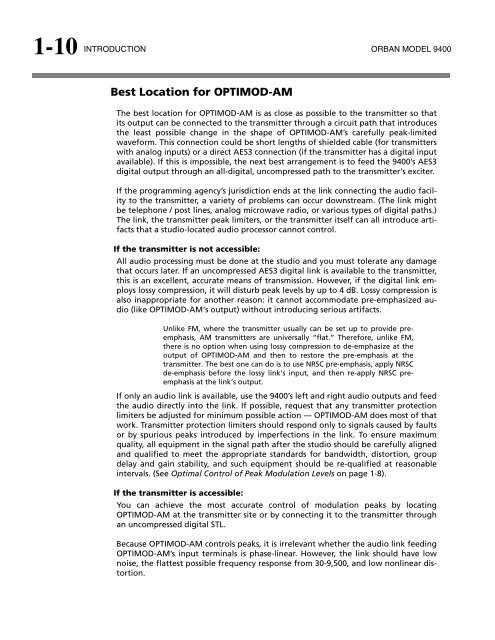Optimod-AM 9400 V1.2 Operating Manual - Orban
Optimod-AM 9400 V1.2 Operating Manual - Orban
Optimod-AM 9400 V1.2 Operating Manual - Orban
- No tags were found...
You also want an ePaper? Increase the reach of your titles
YUMPU automatically turns print PDFs into web optimized ePapers that Google loves.
1-10<br />
INTRODUCTION ORBAN MODEL <strong>9400</strong><br />
Best Location for OPTIMOD-<strong>AM</strong><br />
The best location for OPTIMOD-<strong>AM</strong> is as close as possible to the transmitter so that<br />
its output can be connected to the transmitter through a circuit path that introduces<br />
the least possible change in the shape of OPTIMOD-<strong>AM</strong>’s carefully peak-limited<br />
waveform. This connection could be short lengths of shielded cable (for transmitters<br />
with analog inputs) or a direct AES3 connection (if the transmitter has a digital input<br />
available). If this is impossible, the next best arrangement is to feed the <strong>9400</strong>’s AES3<br />
digital output through an all-digital, uncompressed path to the transmitter's exciter.<br />
If the programming agency’s jurisdiction ends at the link connecting the audio facility<br />
to the transmitter, a variety of problems can occur downstream. (The link might<br />
be telephone / post lines, analog microwave radio, or various types of digital paths.)<br />
The link, the transmitter peak limiters, or the transmitter itself can all introduce artifacts<br />
that a studio-located audio processor cannot control.<br />
If the transmitter is not accessible:<br />
All audio processing must be done at the studio and you must tolerate any damage<br />
that occurs later. If an uncompressed AES3 digital link is available to the transmitter,<br />
this is an excellent, accurate means of transmission. However, if the digital link employs<br />
lossy compression, it will disturb peak levels by up to 4 dB. Lossy compression is<br />
also inappropriate for another reason: it cannot accommodate pre-emphasized audio<br />
(like OPTIMOD-<strong>AM</strong>‘s output) without introducing serious artifacts.<br />
Unlike FM, where the transmitter usually can be set up to provide preemphasis,<br />
<strong>AM</strong> transmitters are universally “flat.” Therefore, unlike FM,<br />
there is no option when using lossy compression to de-emphasize at the<br />
output of OPTIMOD-<strong>AM</strong> and then to restore the pre-emphasis at the<br />
transmitter. The best one can do is to use NRSC pre-emphasis, apply NRSC<br />
de-emphasis before the lossy link’s input, and then re-apply NRSC preemphasis<br />
at the link’s output.<br />
If only an audio link is available, use the <strong>9400</strong>’s left and right audio outputs and feed<br />
the audio directly into the link. If possible, request that any transmitter protection<br />
limiters be adjusted for minimum possible action — OPTIMOD-<strong>AM</strong> does most of that<br />
work. Transmitter protection limiters should respond only to signals caused by faults<br />
or by spurious peaks introduced by imperfections in the link. To ensure maximum<br />
quality, all equipment in the signal path after the studio should be carefully aligned<br />
and qualified to meet the appropriate standards for bandwidth, distortion, group<br />
delay and gain stability, and such equipment should be re-qualified at reasonable<br />
intervals. (See Optimal Control of Peak Modulation Levels on page 1-8).<br />
If the transmitter is accessible:<br />
You can achieve the most accurate control of modulation peaks by locating<br />
OPTIMOD-<strong>AM</strong> at the transmitter site or by connecting it to the transmitter through<br />
an uncompressed digital STL.<br />
Because OPTIMOD-<strong>AM</strong> controls peaks, it is irrelevant whether the audio link feeding<br />
OPTIMOD-<strong>AM</strong>’s input terminals is phase-linear. However, the link should have low<br />
noise, the flattest possible frequency response from 30-9,500, and low nonlinear distortion.



![[PDF] Using the ITU BS.1770-2 and CBS Loudness Meters ... - Orban](https://img.yumpu.com/50629372/1/190x245/pdf-using-the-itu-bs1770-2-and-cbs-loudness-meters-orban.jpg?quality=85)






![[PDF] Optimod-FM Feature Comparison - Orban](https://img.yumpu.com/41741615/1/190x245/pdf-optimod-fm-feature-comparison-orban.jpg?quality=85)





